9.02.2022
GEOMAGNETIC STORM AND RECENTLY DEPLOYED STARLINK SATELLITES
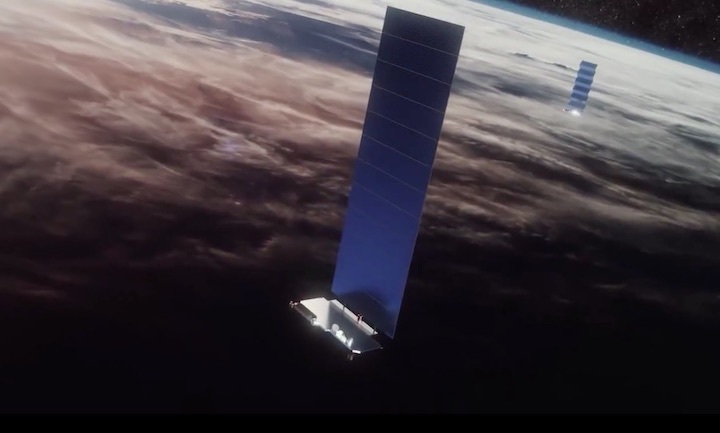
On Thursday, February 3 at 1:13 p.m. EST, Falcon 9 launched 49 Starlink satellites to low Earth orbit from Launch Complex 39A (LC-39A) at Kennedy Space Center in Florida. Falcon 9’s second stage deployed the satellites into their intended orbit, with a perigee of approximately 210 kilometers above Earth, and each satellite achieved controlled flight.
SpaceX deploys its satellites into these lower orbits so that in the very rare case any satellite does not pass initial system checkouts it will quickly be deorbited by atmospheric drag. While the low deployment altitude requires more capable satellites at a considerable cost to us, it’s the right thing to do to maintain a sustainable space environment.
Unfortunately, the satellites deployed on Thursday were significantly impacted by a geomagnetic storm on Friday. These storms cause the atmosphere to warm and atmospheric density at our low deployment altitudes to increase. In fact, onboard GPS suggests the escalation speed and severity of the storm caused atmospheric drag to increase up to 50 percent higher than during previous launches. The Starlink team commanded the satellites into a safe-mode where they would fly edge-on (like a sheet of paper) to minimize drag—to effectively “take cover from the storm”—and continued to work closely with the Space Force’s 18th Space Control Squadron and LeoLabs to provide updates on the satellites based on ground radars.
Preliminary analysis show the increased drag at the low altitudes prevented the satellites from leaving safe-mode to begin orbit raising maneuvers, and up to 40 of the satellites will reenter or already have reentered the Earth’s atmosphere. The deorbiting satellites pose zero collision risk with other satellites and by design demise upon atmospheric reentry—meaning no orbital debris is created and no satellite parts hit the ground. This unique situation demonstrates the great lengths the Starlink team has gone to ensure the system is on the leading edge of on-orbit debris mitigation.
Quelle: SpaceX
+++
SpaceX verliert dutzende Starlink-Satelliten in einem Sonnensturm
Rund 40 Starlink-Satelliten stehen kurz vor ihrer Zerstörung, gab Elon Musks Raumfahrtunternehmen SpaceX bekannt. Wegen eines geomagnetischen Sturms seien diese nicht mehr in der Lage, ihr Ziel zu erreichen.
Durch einen geomagnetischen Sturm im Weltraum ist eine Mission des Raumfahrtunternehmens SpaceX gescheitert. Rund 40 Satelliten werden ihre vorhergesehene Route nicht erreichen, in die Erdatmosphäre eindringen und zerstört werden, teilte das US-Raumfahrtunternehmen mit.
Beim Wiedereintritt werden alle Teile verglühen und kein Weltraumschrott die Erdoberfläche erreichen. SpaceX betont, dass dadurch keinerlei Gefahr besteht, weder im Weltraum, noch auf der Erde. Die Fluggeräte des Unternehmens seien nämlich so konzipiert worden, dass stets die maximale Sicherheit gewährleistet wird.
Das Unternehmen wählt die niedrigeren Umlaufbahnen zum Abwurf der Satelliten aus Sicherheitsgründen: In sehr seltenen Fällen kann es dazu kommen, dass die Verbindung zum Satelliten nicht hergestellt werden kann und SpaceX dadurch keine Kontrolle mehr über den Satelliten hat. Durch die Nähe zur Erde würden diese aber zurück in die Atmosphäre gezogen und daraufhin gefahrlos verglühen.
Quelle: t-online
+++
40 Starlink satellites doomed by geomagnetic storm
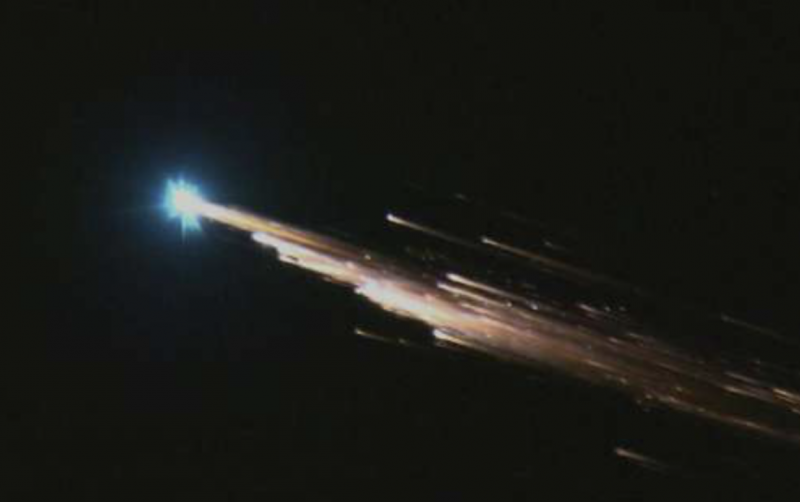
40 Starlink satellites doomed
SpaceX reported last night (February 8, 2022) in its Updates area that 40 of the 49 Starlink satellites it launched to low Earth orbit on February 3 are now doomed by a geomagnetic storm. Such storms are disturbances in Earth’s magnetic field caused by activity on the sun. The satellites were part of SpaceX’s grand plan to launch thousands of Starlink satellites for global internet access. SpaceX said:
… The satellites deployed on Thursday were significantly impacted by a geomagnetic storm on Friday … Preliminary analyses show the increased drag at the low altitudes prevented the satellites from leaving safe-mode to begin orbit raising maneuvers … up to 40 of the satellites will reenter or already have reentered the Earth’s atmosphere.
Geomagnetic storms result from explosive events on the sun, called solar flares. These events have the potential to hurtle charged solar particles across space to the Earth. The impact causes a geomagnetic storm, an event associated with Earth’s beautiful auroras or northern lights. But these events also cause Earth’s atmosphere to warm and “puff up.” Low-orbiting satellites will feel increased atmospheric drag in an atmosphere puffed up during a geomagnetic storm. SpaceX said:
In fact, onboard GPS suggests the escalation speed and severity of the storm caused atmospheric drag to increase up to 50% higher than during previous launches.
The Starlink team commanded the satellites into a safe-mode where they would fly edge-on (like a sheet of paper) to minimize drag, to effectively ‘take cover from the storm’ …
But to no avail.
EarthSky 2022 lunar calendars now available! Order now. Going fast!
Re-entering satellites
It’s possible that one or more of the satellites reentered the atmosphere over the Caribbean recently.
A video from cameras that monitor the skies of Puerto Rico, from Sociedad de Astronomia del Caribe, shows an interesting event that appears to be related: first, an object is seen disintegrating, with noticeable fragmentation, which is characteristic of space debris.
Impressive visuals appear just one minute later, as a bigger object undergoes a spectacular disintegration event. Satellite tracking experts agree the event is probably related to the Starlink satellites launched on February 3, 2022.
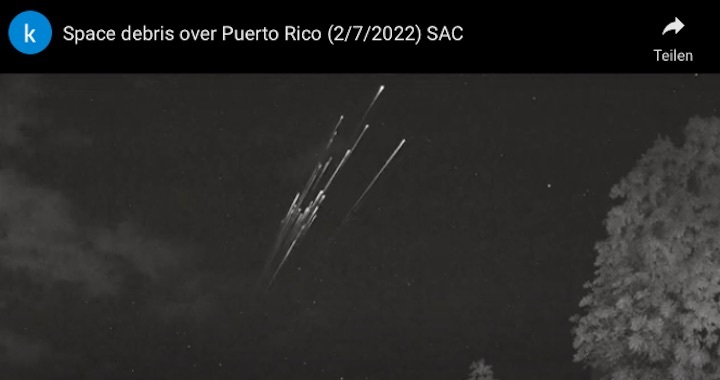
Take a look at the video:
Each Starlink satellite has a size of 10 1/2 feet (3.2 meters) x 5 1/4 feet (1.6 meters) and weights 573 pounds (260 kilograms).
Some of the doomed satellites will be re-entering the atmosphere during the next few days, and although it’s still uncertain exactly where and when, just in case, keep looking up!
More geomagnetic storms expected
SpaceX added that the deorbiting satellites:
… pose zero collision risk with other satellites and by design demise upon atmospheric reentry. [That means] no orbital debris is created and no satellite parts hit the ground.
By the way, the sun is currently in the rising part of its 11-year sunspot cycle (Solar Cycle 25). In other words, solar activity is on an upswing and can be expected to increase in the coming years.
In January 2022, SpaceX passed a 2,000-satellite milestone with its Starlink mission. The overall plan for thousands of Starlink satellites in low Earth orbit has caused controversy in the astronomy community.
Bottom line: On Thursday, February 3, 2022, a SpaceX Falcon 9 launched 49 Starlink satellites to low Earth orbit from Kennedy Space Center in Florida. SpaceX reported on February 8 that at least 40 of those satellites “will reenter or already have reentered the Earth’s atmosphere” due to a geomagnetic storm.
Quelle: EarthSky
+++
SpaceX loses dozens of new Starlink satellites to “geomagnetic storm”
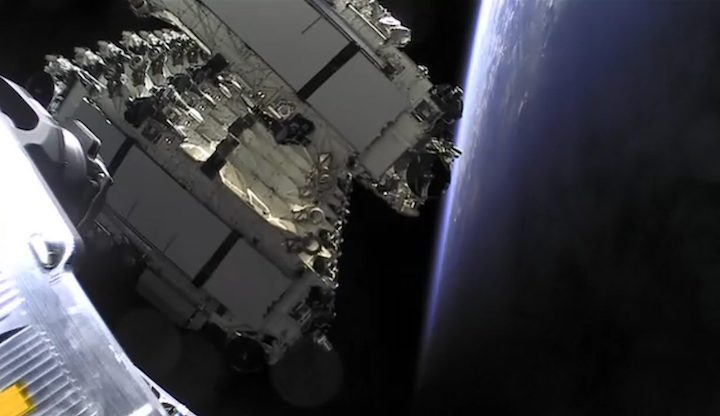
SpaceX says that dozens of the 49 Starlink satellites aboard its most recent Starlink launch may have been doomed by a “geomagnetic storm” that arrived the day after.
In an update published on SpaceX.com, the company revealed that “up to 40 of the [49 Starlink V1.5] satellites [launched on February 3rd] will reenter or already have reentered the Earth’s atmosphere” after the “severity of the storm caused atmospheric drag to increase up to 50 percent higher” relative to past Starlink launches. The incident is likely the first time in spaceflight history that a geomagnetic storm – solar weather – has caused satellites to fail because of its effects on Earth’s atmosphere.
There’s some ambiguity in SpaceX’s statement as to how exactly the storm caused up to 40 Starlink satellites to fail or if those satellites actually failed, per se. According to SpaceX, a geomagnetic storm that began on February 4th caused “the atmosphere to warm and atmospheric density at [the mission’s] low deployment altitudes to increase [up to 50%],” thereby increasing the drag on each Starlink satellite by the same amount. SpaceX intentionally launches almost every batch of Starlink satellites to very low parking orbits with perigees (the point of the orbit closest to Earth) around 200 kilometers (125 mi).
At that altitude, both Falcon 9’s upper stage and malfunctioning Starlink satellites will naturally reenter Earth’s atmosphere in a matter of weeks or even days, thus guaranteeing that satellites that fail early on won’t become space debris. Only the Starlink satellites that pass initial testing in orbit are allowed to raise themselves to operational orbits around 550 kilometers (340 mi), where a failed satellite will instead take years to deorbit. Just 500 kilometers higher, natural decay takes decades or even centuries.
For Starlink 4-7, it’s ambiguous if the radiation environment created by the geomagnetic storm or days of exposure to the edge of the atmosphere actually damaged dozens of Starlink satellites beyond recovery or if they simply deorbited so quickly in the unusual environment that they fell past the point of no return. In the latter scenario, the incident is effectively an unforeseen fluke of nature – especially given that three-dozen other Starlink launches have run into no such issues in the last three years. In the fluke-of-nature scenario, it’s also unclear if SpaceX could have predicted – and thus prevented – the anomaly.
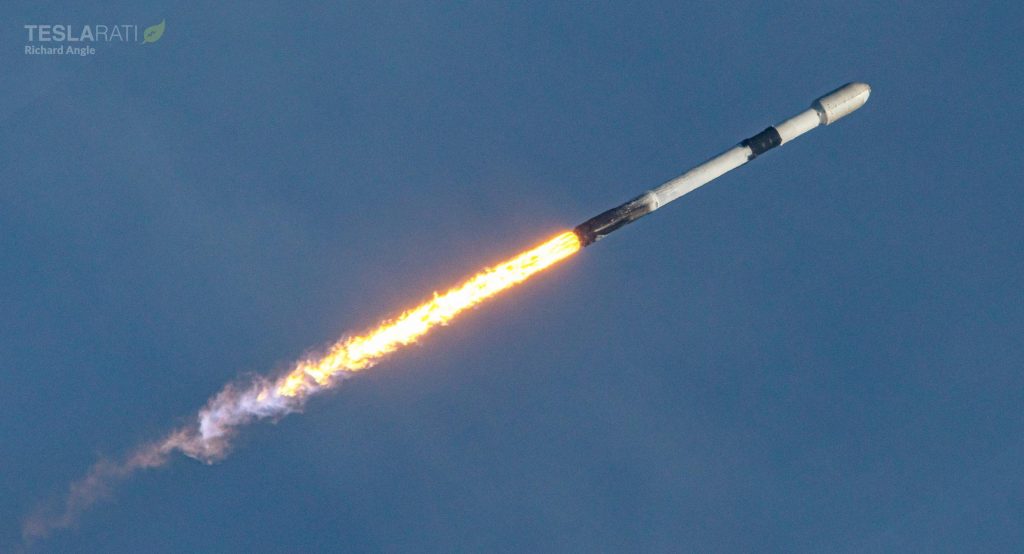
SpaceX says it “commanded the satellites into a safe-mode where they would fly edge-on (like a sheet of paper) to minimize drag” as soon as it was aware of the issue but that “the increased drag…prevented the satellites from leaving safe-mode to begin orbit raising maneuvers.” Based on that phrasing, the most obvious explanation is that the added drag caused up to 40 of the satellites to fall far enough into the atmosphere that their ion thrusters would no longer be able to raise their orbits faster than the drag was lowering them. Raising their solar arrays into the position needed for maximum power generation (and thus maximum sustained thrust) would also drastically accelerate reentry.
The 40 satellites SpaceX believes will be lost likely cost the company anywhere from $10 million to $40 million to build, making for a very expensive lesson. The anomaly also means that SpaceX will likely need to factor in yet another weather condition – geomagnetic storms – into Starlink launch planning. If a bit more time could have saved Starlink 4-7, it’s possible that the company will also consider slightly raising the low parking orbits used for Starlink, trading slightly slower natural reentries to reduce the risk of losing dozens of brand new satellites again.
Quelle: TESLARATI
+++
Dozens of Starlink satellites from latest launch to reenter after geomagnetic storm
MOUNTAIN VIEW, Calif. — Up to 80% of the Starlink satellites launched by SpaceX last week will soon reenter, or have already done so, because a geomagnetic storm kept the spacecraft from raising their orbits.
SpaceX said late Feb. 8 that the 49 satellites it launched Feb. 3 were affected by a geomagnetic storm the next day. Such storms, triggered by solar activity like coronal mass ejections, can increase the density of the upper atmosphere, including at the initial low orbit SpaceX uses to check out Starlink satellite before raising them to their higher operational orbits.
“Onboard GPS suggests the escalation speed and severity of the storm caused atmospheric drag to increase up to 50 percent higher than during previous launches,” the company said. “The Starlink team commanded the satellites into a safe-mode where they would fly edge-on (like a sheet of paper) to minimize drag—to effectively ‘take cover from the storm’—and continued to work closely with the Space Force’s 18th Space Control Squadron and LeoLabs to provide updates on the satellites based on ground radars.”
Exacerbating the problem is the low orbit used by SpaceX for deployment of Starlink satellites, with a perigee of only 210 kilometers. The company says it intentionally uses the low orbit so that any spacecraft that fails initial tests after reaching orbit will quickly deorbit naturally.
That safe mode, though, kept the satellites from raising their orbits using their onboard electric propulsion, and was also not enough to counteract the increased atmospheric drag. “Preliminary analysis shows the increased drag at the low altitudes prevented the satellites from leaving safe-mode to begin orbit raising maneuvers, and up to 40 of the satellites will reenter or already have reentered the Earth’s atmosphere,” SpaceX stated.
The company added that the satellites posed no risk to other spacecraft in orbit and that the spacecraft are designed to burn up completely on reentry.
While SpaceX emphasized the severe nature of the storm, forecasts before the launch, and data collected during it, indicated only a minor storm. NOAA’s Space Weather Prediction Center said Feb. 2 it expected a moderate geomagnetic storm, rated G2 on a scale of G1 to G5, that day, going down to G1 on Feb. 3, the day of the launch. The Space Force’s Space Launch Delta 45 prediced only a low risk from space weather in the last forecast it issued before the launch. Other satellite operators have not reported issues with their spacecraft, but were not in SpaceX’s unique position of having satellites in very low orbits.
The incident could be a precursor for more space weather problems in the future as the sun moves into a more active phase of its 11-year cycle. Solar events have occasionally in the past caused problems for individual satellites, such as damaging or disabling electronics.
This solar cycle, though, will take place amid a boom in the deployment of small satellites in low Earth orbit, many of which do not use customized and expensive radiation-hardened electronics. In a presentation at the SmallSat Symposium here Feb. 8, Carissa Christensen, founder and chief executive of Bryce Space and Technology, said the number of active satellites has grown from about 1,000 five years ago to more than 5,000 today. “That’s a big leap,” she said.
That growth is driven by small satellites, which Bryce defines as those weighing no more than 600 kilograms. In 2016, 126 such satellites were launched, compared to 1,743 in 2021. About three-quarters of the smallsats launched in 2021 belonged to Starlink and another satellite megaconstellation, OneWeb.
Quelle: SN
+++
SPACE STORM KNOCKS OUT LATEST BATCH OF STARLINK SATELLITES
A minor space storm took down much of the latest Starlink batch shortly after launch.
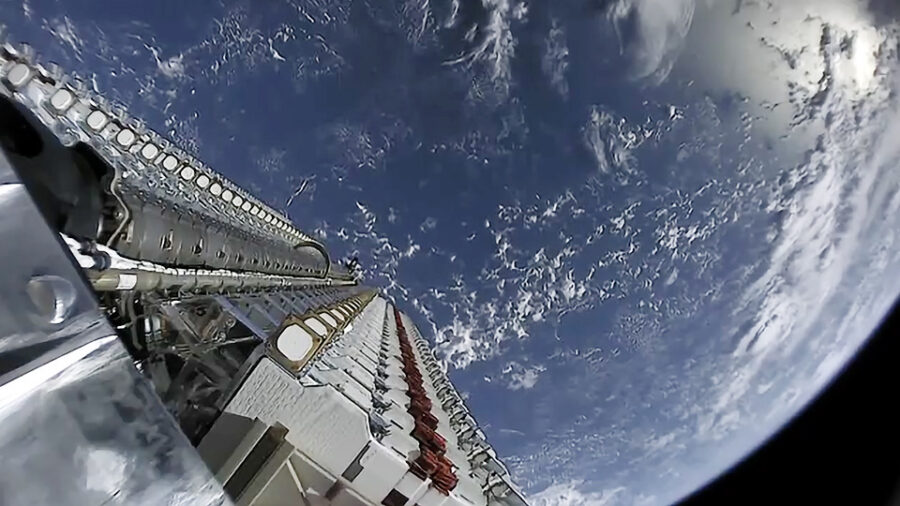
SpaceX
On February 3rd, a SpaceX Falcon 9 rocket launched out of the Kennedy Space Center in Florida with Starlink Group 4-7. The launch, part of a routine addition to SpaceX's Starlink satellite network, went off without a hitch. But it soon became clear that something was amiss.
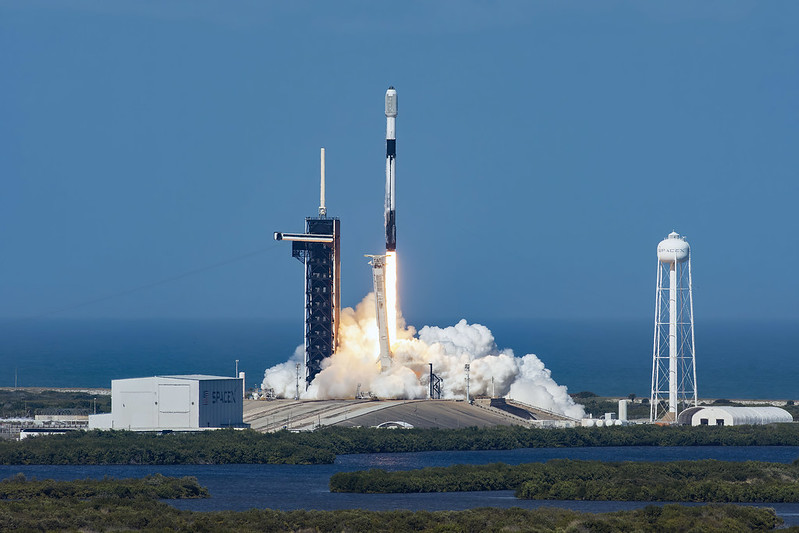
SpaceX
What the worldwide satellite-tracking community picked up on was the initial Two-Line Elements (TLEs) published for the launch by U.S. Combined Space Operations Center Space-Track. Instead of the full complement of 49 satellites plus the usual associated hardware debris, the site listed only four (COSPAR IDs 2022-010A-D). What’s more, the perigees for this initial quintet were all extremely low, around 190 kilometers (120 miles). Reentry predictions soon started popping up on the site shortly after publication.
SpaceX confirmed those suspicions on February 8th, when it released a statement on the loss of up to 40 satellites from the batch. The statement outlined a nominal deployment into an initial 210-kilometer orbit before calamity struck.
SPACE WEATHER WIPEOUT
The culprit was space weather: The Sun released a magnetized bubble of solar plasma known as a coronal mass ejection that struck the Earth environment right around the time of launch. That sparked a minor G1-class geomagnetic storm during the deployment phase for the Starlink satellites.
SpaceX normally releases the Starlinks into a lower initial orbit before boosting them to a higher operational altitude. This technique enables satellites to de-orbit more quickly if they should fail post-deployment checks. But when the geomagnetic storm hit, it caused Earth's upper atmosphere to puff out, and that dramatically increased the drag on the satellites to more than 50% over the normal expected load.

NOAA / SWPC
“Space weather affect satellites differently, depending upon where they orbit Earth,” says space weather physicist Tamitha Skov (The Aerospace Corporation). “For satellites like Starlink in low-Earth Orbit, solar storms are the phenomena that affect them the most dramatically. This is because during a solar storm, the storm’s energy sometimes can get past the Earth’s magnetic shield. When that happens all of the energy gets pumped into the near-Earth system and gets dumped into the Earth’s upper atmosphere.”
REENTRIES
SpaceX controllers reacted immediately to the unfolding events, placing the satellites in safe mode and angling them edge-on with respect to the atmosphere to minimize drag. Meanwhile, LeoLabs and U.S. Space Force’s 18th Space Control Squadron monitored the space weather situation.
However, the maneuvers weren't enough, and the company now expects to lose 40 of the 49 satellites from the batch. The impact of the loss is pretty minimal on the Starlink constellationoverall: SpaceX has been keeping a breakneck launch pace as of late, with 1,888 working Starlink satellites in orbit and counting.
Already, Space-Track has listed six reentries from the failed batch of Starlinks. One was the source of a spectacular early morning reentry on February 7th over Puerto Rico:

Starlinks are about the size of a small coffee table, weighs in at 260 kilograms (570 pounds), small enough that debris from reentries aren't expected to survive to the ground.
Ultimately, the low-altitude release strategy worked as advertised in that it quickly eliminated the failed batch. But such events may become an increasing issue as more satellite constellations head to orbit, and as the Sun, in Solar Cycle 25, heads towards peak activity through 2023-2026. It’s worth noting that the coronal mass ejection and ensuing storm were mild events.
COMMUNITY REACTION
“Many of us in the space weather field have been warning that this would happen at some point, especially as the new solar cycle ramps up,” says Skov. “Activity will continue to ramp up to solar maximum over the next five years so the potential for something like this to happen again in the near future should not be underestimated. As all good sailors know, if we are to bravely sail the seas of space, we should never underestimate the weather.”
Ironically, the plethora of satellites in low-Earth orbit might give space physicists the chance to study the upper ionosphere as it interacts with space weather events. However, for many fields of astronomy, the satellites pose a threat as their streaks across images hinder the search for near-Earth objects, cosmological studies, and other fields.
To address the growing threat, the International Astronomical Union has recently announced it's creating a new center to deal with the satellites' impact on astronomy — not just Starlink but others, too. The center will have multiple "hubs," to deal with multiple issues. One hub will create software to avoid and remove satellite trails in images taken by professional and extremely sensitive telescopes, for example, while another will advocate for policy changes to protect radio frequencies from interference, reduce space junk, and reduce overall impact on astronomy.
SpaceX isn't the only one creating such a network; OneWeb is busy launching its own set of satellites, with its 13th batch launching from the Guiana Space Center this afternoon. OneWeb expects its network to be providing broadband internet to users by the end of 2022.
It’s a brave new world and mitigating the impact of space weather on satellites will become an increasing issue to address in the years to come.
Quelle: Sky&Telescope
